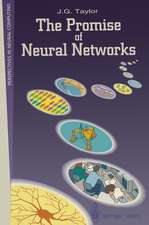Concepts for Neural Networks: A Survey: Perspectives in Neural Computing
Editat de Lawrence J. Landauen Limba Engleză Paperback – 12 noi 1997
Din seria Perspectives in Neural Computing
- 20%
 Preț: 986.66 lei
Preț: 986.66 lei - 20%
 Preț: 651.23 lei
Preț: 651.23 lei - 20%
 Preț: 1159.10 lei
Preț: 1159.10 lei - 20%
 Preț: 987.65 lei
Preț: 987.65 lei - 20%
 Preț: 648.44 lei
Preț: 648.44 lei - 20%
 Preț: 583.14 lei
Preț: 583.14 lei - 20%
 Preț: 989.79 lei
Preț: 989.79 lei - 20%
 Preț: 327.29 lei
Preț: 327.29 lei - 20%
 Preț: 339.34 lei
Preț: 339.34 lei - 20%
 Preț: 639.52 lei
Preț: 639.52 lei - 20%
 Preț: 335.52 lei
Preț: 335.52 lei - 20%
 Preț: 646.80 lei
Preț: 646.80 lei - 20%
 Preț: 647.79 lei
Preț: 647.79 lei - 20%
 Preț: 641.49 lei
Preț: 641.49 lei - 15%
 Preț: 643.99 lei
Preț: 643.99 lei - 20%
 Preț: 329.91 lei
Preț: 329.91 lei - 20%
 Preț: 326.46 lei
Preț: 326.46 lei - 20%
 Preț: 643.50 lei
Preț: 643.50 lei - 20%
 Preț: 398.07 lei
Preț: 398.07 lei - 20%
 Preț: 646.47 lei
Preț: 646.47 lei - 18%
 Preț: 786.36 lei
Preț: 786.36 lei - 20%
 Preț: 326.64 lei
Preț: 326.64 lei - 20%
 Preț: 650.73 lei
Preț: 650.73 lei - 20%
 Preț: 648.26 lei
Preț: 648.26 lei - 20%
 Preț: 652.73 lei
Preț: 652.73 lei - 20%
 Preț: 648.76 lei
Preț: 648.76 lei - 20%
 Preț: 335.18 lei
Preț: 335.18 lei - 20%
 Preț: 334.20 lei
Preț: 334.20 lei - 20%
 Preț: 335.88 lei
Preț: 335.88 lei
Preț: 648.59 lei
Preț vechi: 810.74 lei
-20% Nou
Puncte Express: 973
Preț estimativ în valută:
124.12€ • 129.11$ • 102.47£
124.12€ • 129.11$ • 102.47£
Carte tipărită la comandă
Livrare economică 15-29 aprilie
Preluare comenzi: 021 569.72.76
Specificații
ISBN-13: 9783540761631
ISBN-10: 3540761632
Pagini: 324
Ilustrații: XVI, 312 p.
Dimensiuni: 155 x 235 x 17 mm
Greutate: 0.5 kg
Ediția:1st Edition.
Editura: SPRINGER LONDON
Colecția Springer
Seria Perspectives in Neural Computing
Locul publicării:London, United Kingdom
ISBN-10: 3540761632
Pagini: 324
Ilustrații: XVI, 312 p.
Dimensiuni: 155 x 235 x 17 mm
Greutate: 0.5 kg
Ediția:1st Edition.
Editura: SPRINGER LONDON
Colecția Springer
Seria Perspectives in Neural Computing
Locul publicării:London, United Kingdom
Public țintă
ResearchCuprins
1 Neural Networks: An Overview.- 1.1 Introduction.- 1.2 What is a Neural Network?.- 1.3 Neural Network Dynamics.- 1.4 Training a Neural Network.- 1.5 Problems for Artificial Neural Networks.- 1.6 Problems for Neurobiologically Realistic Neural Networks.- 1.7 Conclusions.- 1.8 Further Reading.- 1.9 Bibliography.- 2 A Beginner’s Guide to the Mathematics of Neural Networks.- 2.1 Introduction: Neural Information Processing.- 2.2 From Biology to Mathematical Models.- 2.3 Neural Networks as Associative Memories.- 2.4 Creating Maps of the Outside World.- 2.5 Learning a Rule from an Expert.- 2.6 Puzzling Mathematics.- 2.7 Further Reading.- 2.8 Bibliography.- 3 Neurobiological Modelling.- 3.1 Introduction.- 3.2 The Single Nerve Cell.- 3.3 Retinal Processing.- 3.4 The Cortical Streams.- 3.5 The Ventral Stream.- 3.6 The Dorsal Stream.- 3.7 Object Construction.- 3.8 Modelling the Processing Streams.- 3.9 Conclusions.- 3.10 Bibliography.- 4 Neural Network Control of a Simple Mobile Robot.- 4.1 Introduction.- 4.2 The Robot ‘Insects’.- 4.3 Neural Network for Obstacle Avoidance.- 4.4 A Compound Eye.- 4.5 Navigation.- 4.6 Discussion.- 4.7 Bibliography.- 5 A Connectionist Approach to Spatial Memory and Planning.- 5.1 Overview.- 5.2 Introduction.- 5.3 Biological Spatial Memory.- 5.4 Connectionist Implementation.- 5.5 An Experiment with a Robot.- 5.6 Discussion.- 5.7 Conclusion.- 5.8 Appendix: Vision system for letter detection and recognition..- 5.9 Appendix: Vision system for state recognition.- 5.10 Appendix: Notes on a biologically plausible implementation.- 5.11 Bibliography.- 6 Turing’s Philosophical Error?.- 6.1 Turing’s Machine.- 6.2 Digital Problems.- 6.3 Turing’s Thesis.- 6.4 How Turing Built his Universal Machine.- 6.5 Gödel’s Attempt to Break Turing’s Thesis.-6.6 Yes-or-No Questions.- 6.7 Material and Formal Proofs.- 6.8 The Dialectica Lecture.- 6.9 A Calculus of Concepts?.- 6.10 Turing’s Error.- 6.11 Further Reading.- 6.12 Bibliography.- 7 Penrose’s Philosophical Error.- 7.1 Can Computers Think?.- 7.2 Solving Problems in Arithmetic.- 7.3 The Barber Paradox.- 7.4 Gödel’s Theorem.- 7.5 Penrose.- 7.6 A Computational Model for Thought?.- 7.7 Can Computers Think?.- 7.8 Appendix: Filling in Some Details.- 7.9 Bibliography.- 8 Attentional Modulation in Visual Pathways.- 8.1 Introduction.- 8.2 Structural Equation Modelling.- 8.3 Design and Image Acquisition.- 8.4 Image Analysis and Categorical Comparisons.- 8.5 Modelling of the Posterior Visual Pathway.- 8.6 Modelling Modulation by Interaction Terms.- 8.7 Interaction Effects Demonstrated with Regression Analysis.- 8.8 Regional Specificity.- 8.9 Conclusion.- 8.10 Bibliography.- 9 Neural Networks and the Mind.- 9.1 Introduction.- 9.2 The Relational Mind.- 9.3 Exploring the Relational Mind Model.- 9.4 Memory in the Relational Mind Model.- 9.5 A Neural Candidate for Global Control.- 9.6 Consciousness and Sites of Working Memory.- 9.7 Awareness of Words.- 9.8 Activity ‘Bubbles’ in Cortex.- 9.9 The Emergence of Qualia.- 9.10 Discussion.- 9.11 Bibliography.- 10 Confusions about Consciousness.- 10.1 Consciousness Studies.- 10.2 Bibliography.- 11 Round Table Discussion.- 11.1 Presentations.- 11.2 Audience Participation.
Caracteristici
The scope of the book means that it will be of interest to a wide range of readers within neural networks - There are currently no other volumes available which provide such broad and comprehensive coverage of the topic - The book focuses specifically on applications of neural networks in the area of robotics





















